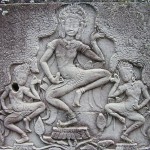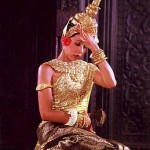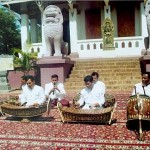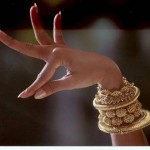People in Cambodia use dance to show the divine power, celebrate the social events, and create laughter in daily life. Cambodian dance can be divided into three different categories: Khmer Classical Dance, Folk Dance, and Vernacular Dance.
Khmer Classical Dance:
This form of dance is also known by a name in English called “Royal Ballet of Cambodia”, and it is listed in UNESCO’s Masterpieces of the Oral and Intangible Heritage of Humanity in 2008. This dance was performed only for royalty meaning the “dances of royal wealth”.
Khmer classical dance is believed to derive from Indian court dance, which traces its origins to the apsaras(see pic1) of Hindu mythology, heavenly female nymphs who were born to dance for the gods. The traditions of Thailand and Java (in Indonesia) also influenced the music and dance of Cambodia.
Over the history of Cambodia, role of Royal Palace’s dancers have become symbols of the King’s prestige. After the signing of the 1863 Protectorate Treaty, the French, who among many other things controlled the country’s finances, tried to reduce the number of palace dancers in order to lessen the King’s prestige. In the 1930s, the French subsidized the private troupe of Princess Wongat Say Sangvann, which performed for tourists, calling it the “one and only true” troupe. But after King Norodom Sihanouk acceded to the throne in 1941, his mother Queen Sisowath Kossamak found ways to reestablish the royal troupe’s ascendancy. In support of her son, Queen Kossamak transformed performances so that the royal troupe could best serve Cambodia’s image nationally and abroad. She shortened the length of the dance programs, had pure dance pieces followed by dramatic or comic works, and added musical interludes.
However, the tradition of dance, last for over a millennium, was almost lost in the Cambodian genocide, when the Khmer Rouge targeted those involved in the dance and “imposed a massive cultural forgetting”. Khmer classical dance suffered a huge blow during the Khmer Rouge regime when many dancers were killed because classical dance was thought as of an aristocratic institution. Although 90 percent of all Cambodian classical artists perished between 1975 and 1979 after the fall of the Khmer Rouge, those who did survive wandered out from hiding, found one another, and formed “colonies” in order to revive their sacred traditions.*
*(Reference: Earth in Flower – The Divine Mystery of the Cambodian Dance Drama by Paul Cravath)
Khmer classical dancers use silent movements and gestures to tell a story. Dancers do not speak or sing; they dance with a slight smile and never open their mouths.(see pic2) Khmer classical dance can be compared to French ballet in that it requires years of practice and stretching at a young age so the limbs become very flexible.
In classical Cambodian dance, women, dressed in brightly colored costumes with elaborate headdresses (also see pic2), perform slow, graceful movements accompanied by a percussive ensemble known as the pinpeat. Pinpeat orchestras include drums, gongs, and bamboo xylophones. (see pic3)
The way Khmer classical dance communicate with audience is very complicated. Different position of the arm and the position of the hand relative to the arm can also express different meaning. Besides hand gestures are gestures which are more specific to their meaning, such as that which is used to represent laughing or flying. These other gestures are performed in different manners depending on which type of character is played.
In addition to the renowned graceful hand gesture(see pic4) and stunning costumes, the Khmer Classical Dance, has been closely associated with the Khmer court for over one thousand years. Performances would traditionally accompany royal ceremonies and observances such as coronations, marriages, funerals or Khmer holidays. This art form is highly cherished by many Cambodians.
Infused with a sacred and symbolic role, the dance embodies the traditional values of refinement, respect and spirituality. Its repertory perpetuates the legends associated with the origins of the Khmer people. Consequently, Cambodians have long esteemed this tradition as the emblem of Khmer culture. Four distinct character types exist in the classical repertory: Neang (woman), Neayrong ( man), Yeak (giant), and Sva (monkey). Each possesses distinctive colours, costumes, makeup and masks. An orchestra accompanies the dance, and a female chorus provides a running commentary on the plot, highlighting the emotions mimed by the dancers, who were considered the kings’ messengers to the gods and to the ancestors.
Classical Cambodian Ballet: Apsara
Folk dance:
Folk dances play a role of performing art to entertain the audience. Khmer folk are fast-paced, and the movements and gestures are not as stylized as Khmer classical dance. Folk dances mostly are about love or the story about animals. The dancers wear costumes that portray ordinary people character, such as farmers, peasants, and tribe leaders. The elements of folk dance diversify profoundly by different area and local cultures. The most famous of all, Robam Trot, is mainly performed during the Cambodian New Year. The Dance got its history along a legend about a hunter and deer.
Vernacular dance:
In Cambodia, vernacular dance (or social dance) is the dance performed at social gatherings. Some of these dances are heavily influenced by the traditional dances of Laos. But rom kbach, for example, take heavily from the classical dance of the royal court. Rom kbach is a simple dance which uses hand gesture similar to that of classical dance and rom kbach song also utilize the melodies of classical dance songs and combine them with traditional Khmer and Western instruments.
Other social dances from around the world have had an impact on Cambodian social cultures include the Cha-Cha,Bolero, and the Madison. Such dances are often performed at Cambodian wedding receptions and banquets.
Yosuke and Tan-Chi





Glad to be here https://bit.ly/40TNy8B
Nice content! thx https://bit.ly/3K9xpGq
Interesting information. Thanks https://bit.ly/3lBf6j3
Glad to be here, thank you all https://bit.ly/3K9sYeE
Very good job, thank you https://bit.ly/3jVPtsE
Unbelievable job was done https://bit.ly/3IrkBKe
Wow, I am really impressed https://bit.ly/41826BQ
The publication was very interesting for me https://bit.ly/3ImLTRR
Nice blog and very useful content https://bit.ly/3xoIR9y
It is helped me a lot, thank you https://bit.ly/3Injc7m
Very helpful , thank you so much https://bit.ly/40Oxxki
What a fantastic post! https://bit.ly/3Ip6Prr
Very cool, I liked it. https://bit.ly/3IqMH8e
Very useful post! https://bit.ly/3InjbAk
Like your service, well done https://bit.ly/3lBztN4
Cool, very useful article. https://bit.ly/3IpaLs4
This post very helpful for me https://bit.ly/40VjBoC
Good information, recommend https://bit.ly/3Im0pJv
Thanks for this fantastic blog! Wow! https://bit.ly/3xqQSL8
I like your all post. You have done really good work. Thank you for the information you provide, it helped me a lot. I hope to have many more entries or so from you. Very interesting blog.
IGNOU Project Help
My self Jim Witt, I’m working as a technology consultant. Xtreem Solution is a leading EScooter Mobile App Development in the USA, z library alternatives offering services in iOS, Android, React, IoT, Blockchain, Flutter, and fuel gas delivery app development on your selected technologies.
پنجره هافمن
I was reading this article and find it very informative. https://bit.ly/3ImZ59c
Great blog site!
Thanks this made for interesting reading. https://bit.ly/3IqbhpV
This specific info is great https://bit.ly/3IpfJVD
Thank you for your nice post. https://bit.ly/3xqbV04
I really enjoy to visit this type of post. https://bit.ly/3K9Htz8
Very fine work https://bit.ly/3K7qY6q
Excellent post https://bit.ly/40Oxwge
Phenomenal article https://bit.ly/3jYY8L4
That’s really nice https://bit.ly/41825hg
That’s great! https://bit.ly/40XpmlN
Well done, Perfect!!!
https://bit.ly/3jZkcoS
That’s an interesting article. I’m finding this. Thank you very much. https://bit.ly/3Iq09cx
Very helpful information. Thanks for sharing this with us. https://bit.ly/3k0N3ZU
Its really good thank you so much.
https://bit.ly/3Iq7LvB
Amazing information to know. https://bit.ly/3K8mb4X
It is a very informative topic. Thank you https://bit.ly/3xmzDdB
So nice… Well Explained! https://bit.ly/40ZDGdJ
We need more so helpful articles https://bit.ly/3jRLBJr
This has been an amazing help. https://bit.ly/3IrL7mM
Interesting news! https://bit.ly/3K52bjy
Thank you for nice post! https://bit.ly/3xnItYJ
This is very nice. Thank you https://bit.ly/3Iq9wZS
Thanks for sharing this information guide for all master card users.
https://bit.ly/3E78kru
Very helpful. Thank you. https://bit.ly/3K5yyyr
Nice information and great article https://bit.ly/3IpL7DB
Very nice article! Thanks for information. https://bit.ly/3xoJbEZ
Thanks! Very helpful post https://bit.ly/3K8GvTt